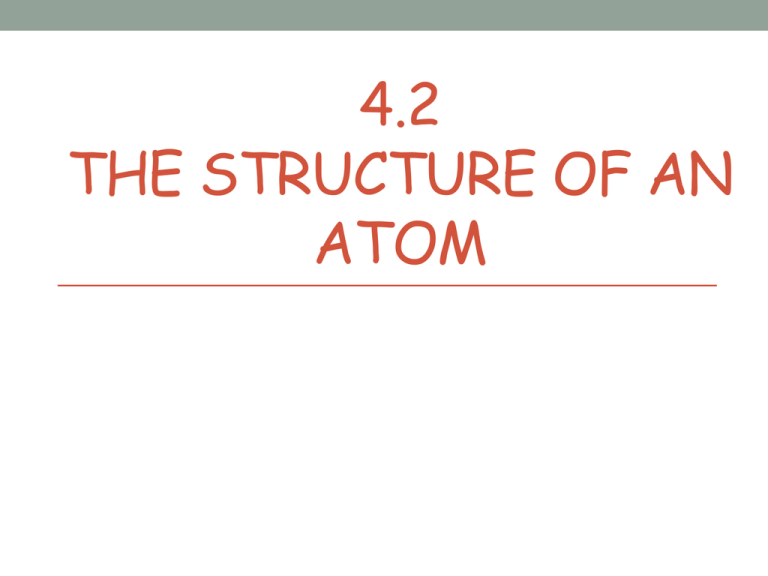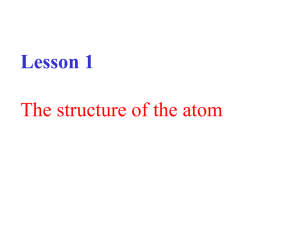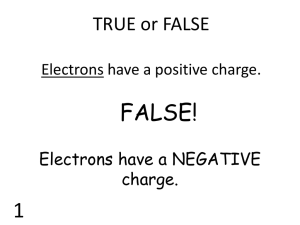Atomic Structure
advertisement

4.2 THE STRUCTURE OF AN ATOM Atomic Structure • Atoms are composed of 2 regions: • Nucleus: center of atom that contains mass of atom • Electron cloud: region that surrounds nucleus that contains most of space in atom Electron Cloud Nucleus What’s in the Nucleus? • Nucleus contains 2 of 3 subatomic particles: • Protons: subatomic particle w/ 1+ charge (p+) • Rutherford - 1911 • Neutrons: subatomic particle w/ no charge (no) • James Chadwick - 1932 What’s in the Electron Cloud? • The 3rd subatomic particle resides outside nucleus in electron cloud • Electron: subatomic particle w/ 1- charge (e-) and virtually no mass • JJ Thomson - 1897 How do these particles interact? • Protons and neutrons live compacted in tiny nucleus • most atom’s mass • electrons small and reside outside nucleus • small mass (2000 e- = 1 p+ or no) • occupy large volume of space outside nucleus Atoms How do the subatomic particles balance each other? • In atoms: • protons = electrons • If 20 protons are present in atom then 20 electrons balance overall charge of atom—atoms are neutral • The neutrons have no charge; therefore they do not need to (and often times don’t) equal protons or electrons How do we know the number of subatomic particles in an atom? • Atomic #: indicates # of protons in atom • Ex: Hydrogen’s atomic # is 1 • hydrogen has 1 proton • Ex: Carbon’s atomic # is 6 • carbon has 6 protons **Number of protons identifies element similar to how your fingerprint ID’s you. Ex. 2 protons = He, 29 protons = Cu ALWAYS!! How do we know the number of subatomic particles in an atom? • Mass number: number of protons and neutrons in nucleus (p+ + no) • Ex: hydrogen can have a mass # of 3. Since it has 1 proton it must have 2 neutrons • # of neutrons = mass # - atomic # What are Isotopes? • Atoms of same element with different # of neutrons • Same atomic # • Different mass # (b/c neutrons are different) • Ex. Carbon 12, Carbon 13, and Carbon 14 all naturally occurring isotopes of Carbon. • Each has 6 p+ and 6 e-, but each has different # of neutrons (therefore, different mass#) Determining the number of protons and neutrons • Li has mass # of 7 and atomic # of 3 • Protons = 3 (same as atomic #) • Neutrons= 7-3 = 4 (mass # - atomic #) • Ne has a mass # of 20 and an atomic # of 10 • Protons = 10 • Neutrons = 20 - 10= 10 What about the electrons? • electrons are equal to protons • So e- = p+ = atomic # • Ex: He has mass # of 4 and atomic # of 2 • p+ = 2 • no = 2 • e- = 2 Basic Atomic Structure 1:57 Determine the number of subatomic particles in the following: • Chlorine has a mass # of 35 and an atomic # of 17 • p+ = 17, no = 18, e- = 17 • Potassium has a mass # of 39 and an atomic # of 19 • P+ = 19, no = 20 e- = 19 Candy Atoms • Atom #1 - mass # of 5 and an atomic # of 3. • Atom #2 – 5 protons and 7 neutrons. • Atom #3 – Atomic # of 7 and 8 neutrons. Candy Atoms • Atom #4 – mass # 18 and 9 electrons • Atom #5 – build your own candy atom using the candies that you have. You should be able to accurately determine: • Atomic # • Mass # • # of protons, neutrons, and electrons 4.3 Modern Atomic Theory Bohr Model of the Atom • Agreed with Rutherford • Small nucleus w/ lots of space • Devised planetary model • trying to show why e- were not sucked into p+ in nucleus of atom. • e- in specific energy levels Misconceptions from the Bohr Model • Bohr model good for diagramming atoms and energy levels • e- do NOT move like planets in predictable orbits • Mathematics determine probable location of e- Energy Levels • Possible energies e- can have • Like floors in hotel • Floor nearest nucleus - ground floor The Electron Hotel • Levels nearer nucleus have lower energy (ground floor of hotel) • Electrons fill energy levels from inside - outside. (ground floor - top floor of Electron Hotel) Electron distribution in an Atom 3d 3p Energy Level 3 ENERGY 3s 2p 2 2s 1 1s NUCLEUS Energy Levels • Can’t stand “in between” steps in hotel stairwell • e-’s can’t exist “in between” energy levels • Must absorb right amt of energy in order to move up energy levels • Must lose right amt to move down Evidence of Energy Levels • Energy gains & loses can be measured • As e- drop orbitals, energy released in form of light/heat • Like in fireworks (2:34) Electron Cloud Model • Electrons travel around nucleus in random orbits. • cannot predict location at any given moment. • Electrons travel so fast, they appear to form a “cloud” around nucleus. • Ex. - Airplane propeller Atomic Orbitals • Rooms in “Electron Hotel” • Region of space where e- likely located • Each orbital can have 2 e- max • Denser region = higher probability Energy Levels, Orbitals, and Electrons Energy Level (floors in hotel) Number of Orbitals (hotel rooms) Maximum number of electrons (occupants) 1 1 2 2 4 8 3 9 18 4 16 32 Electron Configuration • Arrangement of e-’s (occupants) in orbitals (rooms) • Each orbitals holds 2 e-’s max (1 double bed) • Stable when e-’s in orbitals w/ least energy • Ground state • i.e. Lithium (atomic # = 3) has 1st 2 e-’s in the 1st energy level (fills up 1 room w/ double bed) • 3rd e- goes to 2nd energy level Electron Configuration • If Lithium absorbs enough energy, 3rd ejumps energy levels • Excited state • Less stable (like gymnast on beam) • Eventually releases energy (often as light) • Returns to ground state How exactly are the particles arranged? • Bohr Model of the atom: Electrons move in orbits at fixed distances from the nucleus (planetary model) The 3rd ring can hold up to 18 eThe 4th ring and any after can hold up to 32 e- All of the protons and the neutrons The 1st ring can hold up to 2 eThe 2nd ring can hold up to 8 e- What does carbon look like? Mass # = 12 atomic # = 6 6 p and 6 n live in the nucleus p+ = 6 no = 6 e- = 6 Drawing Atoms • Draw the following atoms in your notes: • 1. Beryllium has an atomic # of 4 and a mass # of 9 Beryllium Atom Drawing Atoms • 2. Sodium has an atomic # of 11 and a mass # of 23 Sodium Atom










